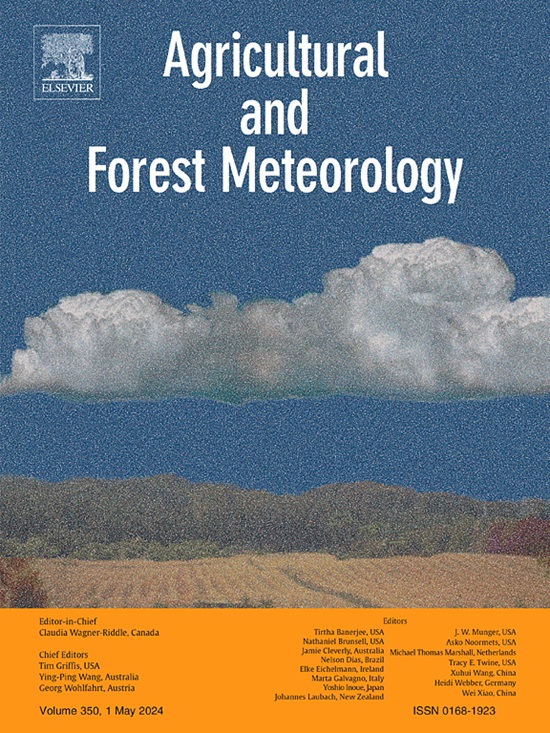Environmental characterization for rainfed maize production in the US Great Plains region
IF 5.7
1区 农林科学
Q1 AGRONOMY
引用次数: 0
Abstract
Identifying regions with similar productivity and yield-limiting climatic factors enables the design of tailored strategies for rainfed maize (Zea mays L.) production in vulnerable environments. Within the United States (US), the Great Plains region is susceptible to weather fluctuations, particularly in Kansas, where rainfed maize production is a significant agricultural activity. This study aims to delimit environmental regions with similar crop growth conditions and to identify the main climatic factors limiting rainfed maize yield, using the state of Kansas as a case study. For this purpose, databases encompassing the period from 1993 to 2021 period, including NOAA weather station data (n = 208), USDA county maize yield data, and crop phenology reports at the agricultural district scale, were compiled for analysis. Four periods based on crop phenology data were defined: fallow period, vegetative period, critical period around flowering (± 15 days), and grain filling period, each with reported climatic variables. A Fuzzy c-means clustering algorithm identified ten productive regions. Grain yields range from ∼3500 to ∼7500 kg ha−1, spanning South-West to North-East regions. Within each region, correlation analysis was carried out between detrended yields and climatic anomalies to identify the most relevant seasonal climatic factors over 29 years. Extreme degree days (i.e., accumulating maximum air temperature above 35 °C) and vapor pressure deficit during the critical period are the main climatic drivers of rainfed maize yield across regions. In Kansas, extreme degree days exhibit a east-to-west and north-to-south increase. Yield decreased by 46 kg ha−1 per °Cd of extreme degree days during the critical period across regions, with maximum yield penalty in the south-east region. This methodology contributes to the knowledge of the most relevant climatic drivers of rainfed maize, with the potential for application in other regions for the development of adaptive management strategies and policies.
美国大平原地区雨水灌溉玉米生产的环境特征
确定具有相似生产力和产量限制性气候因素的地区,可为脆弱环境中的雨水灌溉玉米(Zea mays L.)生产设计量身定制的战略。在美国,大平原地区很容易受到天气波动的影响,尤其是堪萨斯州,那里的雨水灌溉玉米生产是一项重要的农业活动。本研究旨在以堪萨斯州为例,划定作物生长条件相似的环境区域,并确定限制雨浇玉米产量的主要气候因素。为此,我们汇编了 1993 年至 2021 年期间的数据库,包括 NOAA 气象站数据(n = 208)、美国农业部县级玉米产量数据和农业区尺度的作物物候报告,以供分析。根据作物物候数据定义了四个时期:休耕期、植株期、开花前后关键期(± 15 天)和籽粒灌浆期,每个时期都有报告的气候变量。模糊 c-means 聚类算法确定了 10 个高产区域。谷物产量从每公顷 3500 至 7500 千克不等,横跨西南至东北地区。在每个区域内,对去趋势产量和气候异常进行了相关性分析,以确定 29 年中最相关的季节性气候因素。极端度日(即累积最高气温超过 35 °C)和临界期蒸汽压力不足是各地区雨浇玉米产量的主要气候驱动因素。在堪萨斯州,极端度日呈现出自东向西、自北向南的增长趋势。各地区临界期内极端度日每升高 1°Cd 产量减少 46 千克/公顷,东南部地区产量损失最大。这种方法有助于了解与雨水灌溉玉米最相关的气候驱动因素,并有可能应用于其他地区,以制定适应性管理战略和政策。
本文章由计算机程序翻译,如有差异,请以英文原文为准。
求助全文
约1分钟内获得全文
求助全文
来源期刊
CiteScore
10.30
自引率
9.70%
发文量
415
审稿时长
69 days
期刊介绍:
Agricultural and Forest Meteorology is an international journal for the publication of original articles and reviews on the inter-relationship between meteorology, agriculture, forestry, and natural ecosystems. Emphasis is on basic and applied scientific research relevant to practical problems in the field of plant and soil sciences, ecology and biogeochemistry as affected by weather as well as climate variability and change. Theoretical models should be tested against experimental data. Articles must appeal to an international audience. Special issues devoted to single topics are also published.
Typical topics include canopy micrometeorology (e.g. canopy radiation transfer, turbulence near the ground, evapotranspiration, energy balance, fluxes of trace gases), micrometeorological instrumentation (e.g., sensors for trace gases, flux measurement instruments, radiation measurement techniques), aerobiology (e.g. the dispersion of pollen, spores, insects and pesticides), biometeorology (e.g. the effect of weather and climate on plant distribution, crop yield, water-use efficiency, and plant phenology), forest-fire/weather interactions, and feedbacks from vegetation to weather and the climate system.

 求助内容:
求助内容: 应助结果提醒方式:
应助结果提醒方式:


